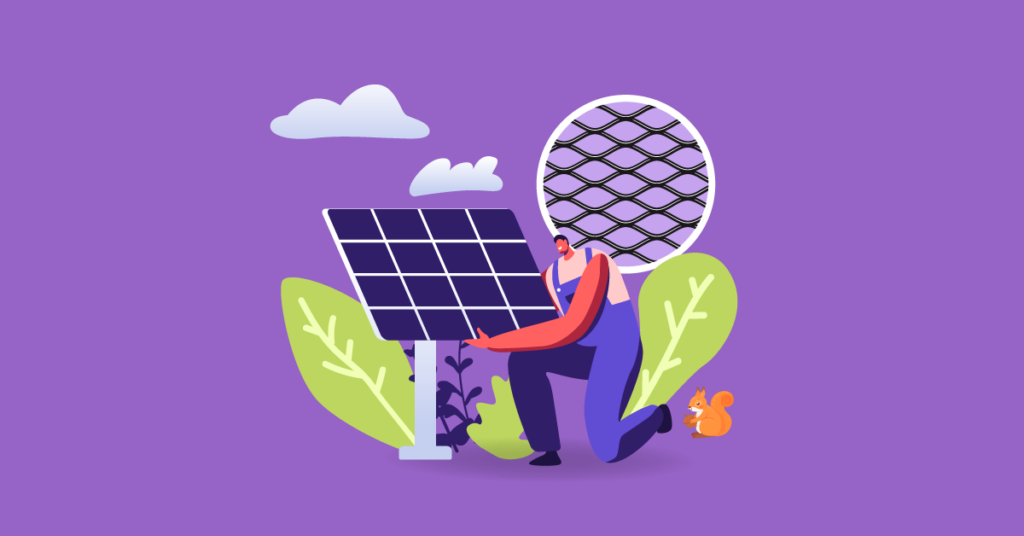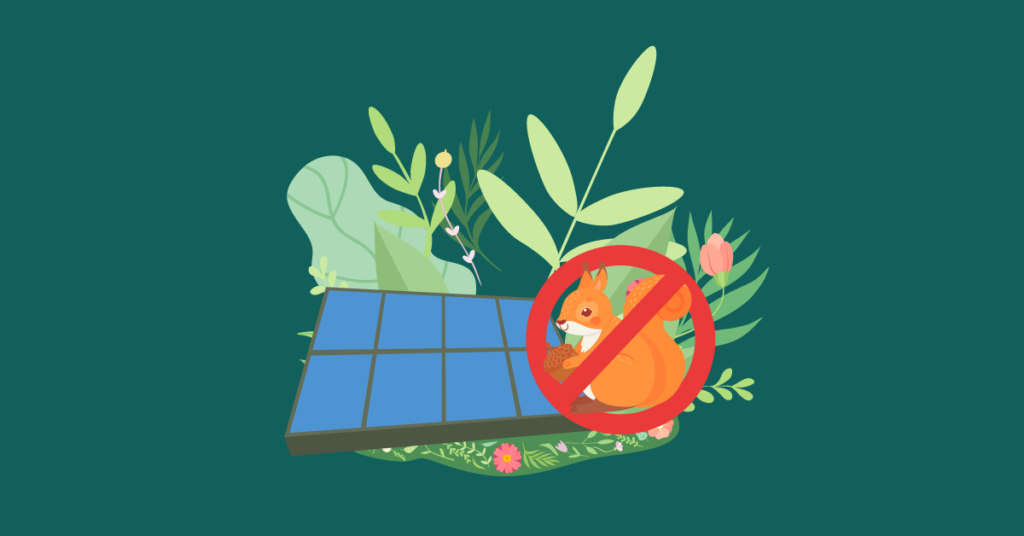Critter guards, also known as solar screens, protect the infrastructure that supports solar panels, keeping out small animals and birds. These guards provide a barrier between the support infrastructure and anything that might find its way underneath.
Squirrels and other rodents can chew up wires, doing thousands of dollars in damage over a single season. Nesting birds perched on, under, and near solar panels can also leave debris behind, impacting efficiency. Leaves and other debris carried by the wind can also build up underneath, creating hazards. When necessary, we use critter guards to keep the area under solar panels undisturbed.
What Does a Critter Guard Look Like?
A critter guard looks like a heavy, metal screen on a slightly larger scale than you use in your windows. Durable mesh designs trap small animals outside. Guards surround the entirety of your solar array, keeping out things like animals and leaves.
Since solar panels are often on your roof, you may not have to worry about common lawn debris, but squirrels can easily make it to your roof. If you’ve ever cleared a bird’s nest from your gutters, you know that flying critters can also be a problem for any rooftop installation. Even when birds don’t build a nest, their droppings get all over the place and can cover your panels.
Critter guards are essentially a fence line that helps keep wildlife away from your solar array.
Do Critter Guards Kill Your Curb Appeal?
No, critter guards don’t have much effect on your curb appeal. While solar panels are often obvious from a block away, even panels have options to blend in and avoid affecting the appearance of your home. The Department of Energy recommends BIPV setups to integrate solar panels into the look of your home.
Critter guards don’t need much in the way of disguising due to their installation location. In most cases, you can’t see these solar screens from street level. Since solar panels are installed on top of a rack, guards go underneath and can be inset to avoid any visuals you don’t like. Ultimately, critter guards impact your home’s appearance less than your gutters.
Risks With an Unprotected Solar System

While power outages are one of the most common problems you might face without critter guards, other risk factors can do even more damage. For example, when gathered under your solar array, leaves and other debris pose a significant problem.
Regardless of the panels used, every solar array is mounted on a rack. That means your panels are never installed flush to your roof. Therefore, an access area underneath allows greenery and fall leaves to build up in that area.
Wet leaves on a roof can lead to damp spots, which eventually erode your roof, causing roof rot. In addition, dry leaves can create the conditions for a fire. After all, solar panels heat up as they gather energy. If too much heat transfers to a pile of dry leaves, the result is a fire.
By creating a physical barrier that prevents buildup under your array, critter guards protect the integrity of your roof.
Should You Install Critter Guards?
Whether or not you need critter guards depends on your location and local wildlife. But, since wildlife-related outages make up the 2nd most common cause of power disruption, it’s often a good idea. Industry estimates say that wildlife causes power loss for 13 million Americans annually.
When you generate power at your home, mitigating those outages falls to you. While solar panels are typically more robust than power lines, there are similar challenges when protecting against small rodents—squirrels, in particular.
Critter guards are likely a good idea if you regularly see squirrels and other small animals that can climb. Investing in solar screens might also be a good idea if you live in a wooded area or near a large tree that sheds its leaves every fall.
Are Critter Guards Always a Necessity?
No, critter guards aren’t required when installing solar panels. In fact, most solar arrays are installed without critter guards. While a buildup of leaves and debris can cause a fire, it’s a rare complication. Likewise, roof rot is equally rare.
However, squirrels are notoriously tricky to keep away from roofs, and birds are also problematic. Suppose you do develop a bird’s nest under your solar array. In that case, it can lead to various problems, including expensive relocation efforts, if you wind up with an endangered species nesting on your roof.
If you’ve ever had a bird’s nest in your gutters or noticed one near your home, installing critter guards delivers great peace of mind.
Since rodents chew wires, squirrels could also be a significant reason to install a barrier. After all, even if squirrels only occasionally interact with your solar panels, these units are meant to last for 25 years or more. With a quarter of a century to get through, wildlife interference is likely if you live near animals that might climb on your roof. So while not a requirement, critter guards help your solar panels last longer and operate at optimal levels.
How Do You Install Critter Guards?
If you’re installing solar panels for the first time, you can roll in critter guard installation. Most installation companies offer upgrades, including guards to keep out debris and wildlife. If your home already has an array, you should make calling your installer a priority; your installer knows the ins and outs of your system and how to put up protections that won’t impact performance.
However, if your local installer doesn’t offer critter guard installation, most will still provide a recommendation for a provider. Get a qualified installer with a good reputation with a call to your solar panel experts.
You might also be interested in: Is Pest Control Worth The Money? [And 3 Benefits Of Professional Services]




